The ‘Haithabu bag’ (or the ‘Hedeby bag’) is one of the referred names within the reenactment world to a bag made of a fabric or leather pouch attached to two wooden handles. The modern name derives from the trading settlement in Schleswig-Holstein known as Haithabu (in German), or Hedeby (in Danish/Swedish). Haithabu was the second largest Nordic city during the Viking Age and used to be the oldest city in Denmark until it became part of Germany after Denmark first loosing the area to Austria and Prussia in 1864.
Though similar handles (both made of wood and bone) have been discovered in Birka and other parts of Uppland, Sweden, I will simply refer to it as the ‘Haithabu bag’ as the handles I made for my bag are based on one of the handles from Haithabu, as presented below.
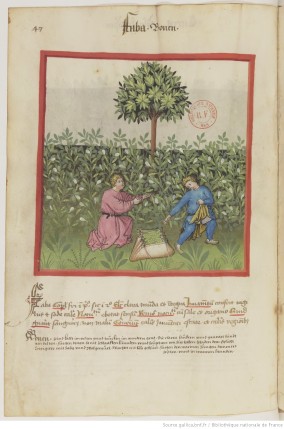
Unfortunately there is scare evidence to support the entire Haithabu model as it is generally recreated today. But pieces of both wooden and bone handles together with traces of fabric, and even entire pouches, sum up a pretty decent base for an interpretation of what a bag might have looked like. I have based my reconstruction on several discoveries in both Germany and Sweden and the already existing theories surrounding them.
Not surprisingly though, I haven’t found any pictorial evidence of the usage of frame bags during the Viking Age. There are a few frame bags pictured later during the Middle Ages, e.g. from Ibn Butlán’s Tacuinum Sanitatis so we know that they did exist in later periods.
In regards to archaeological evidence I’ve looked at handles from Haithabu, Germany and Birka and Uppsala, Sweden.
Firstly, there’s the lath of wood from Haithabu which was found with remnants of wool (yarn or fabric) looped through its slots. I haven’t gotten my hands on a copy of Florian Westphal’s “Die Holzfunde von Haithabu” yet but I’ve read through all the material I could find online regarding the different wooden handles from Haithabu. A few of them are displayed at the Haithabu Museum in Germany and these ash and maple pieces are described by Westphal to “have a length of 181-495 mm and a thickness of 7-13 mm. In the middle section they are 29-52 mm wide. The semi-circular borders have diameters of 31-61 mm and are all centrally pierced (7-10 cm)”. These are the measurements on which I choose to base my own reconstruction.
I’ve also looked more closely at the handle found in central Uppsala, Sweden.

Arvid Julius describes in “Ett lappländskt jordfynd från Uppsala” the size and design of the handle and compares it to the reindeer- and elk horn handles found in Birka, Sweden. He writes that the handle is “provided with semicircular indentations along the long sides. These indentations show traces of heavy wear. The outer field is exclusively ornamented with zigzag lines. Along the handle’s lower side there are six holes, whose function was related to the usage and closure of the bag.”
Julius also writes that “fig. 5-7 depicts three handles used for food sacks made of leather, from Lappland, which are 20, 24 and 22 cm long. Amongst these, fig. 5 is from Piteå, Lappland, fig. 6 is from Torneå, Lappland and fig. 7 is from Russian Lappland (…). All pieces are made of reindeer antlers. It is evident that the Uppsala discovery is such a bag handle. The rectangular hole of the Uppsala specimen indicates a locking structure; a hypothesis which is further supported by markings of wear and tear. This hole is generally missing on the handles found in Lappland, with one exception depicted in fig. 6.”
Julius further debates on the theory that the horn handles were made by the Lappish people in the north (since they carry all the northern ‘trademarks’ when it comes to design) and were imported to Uppland where they specifically were used as bag handles. It is sadly not presented how he comes to this conclusion nor what he bases his knowledge on. Neither is the theory that the bags were made of leather ever presented. It is not an unlikely theory though if you look at the leather belt bags found in Birka.
The above images are with permission borrowed from The Swedish National Maritime Museums and their photographer, Jim Hansson.
The handles from Birka (listed above and including the one on display at the Maritime Museum in Stockholm), found by marine archaeologist Jim Hansson, are very similar in design to the handles mentioned above so I haven’t gone further into researching them. To learn more about the handles from the 2014 Birka excavations you can read Nina Eklöf’s, archaeologist at the Swedish National Maritime Museum, blog entry on the subject (English translation at the end).
In regards to the construction of the bag itself I’ve looked at the oblong piece of leather found in Schleswig-Holstein that, based on its construction, most likely was used together with one or several bag handles. “Die Holzfunde von Haithabu” also presents the Sápmi bag that was found with a round base bag made of cowhide, attached to a wooden handle with a braided (shoulder?) string.
This might not be evidence enough depending on how historically accurate you set out to be in your reenactment and on what grounds you feel the need to support your work. I personally enjoy the struggle with very few remnants of evidential material as it enforces your own interpretation. Based on the simpler drawings of the Haithabu handles I designed the model below to base my own bag on.

The handles are stenciled and cut from an oak baseboard, basically because this was a much cheaper option than going for ash or maple.
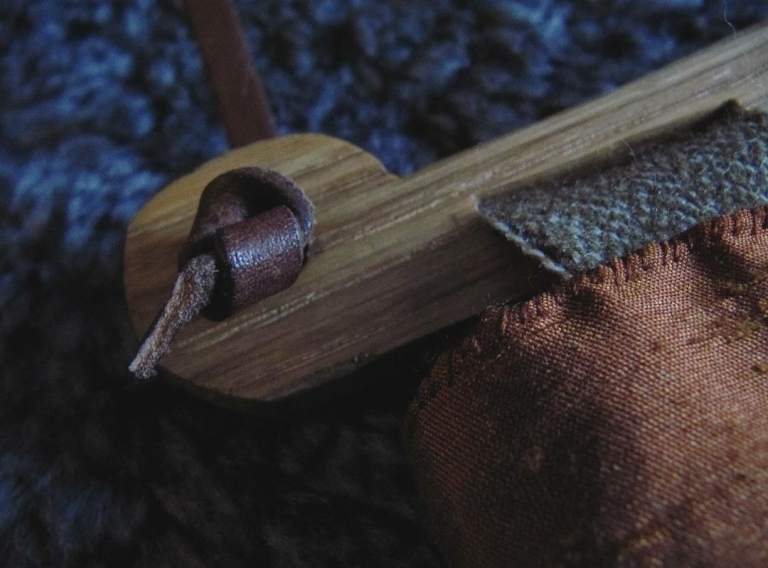


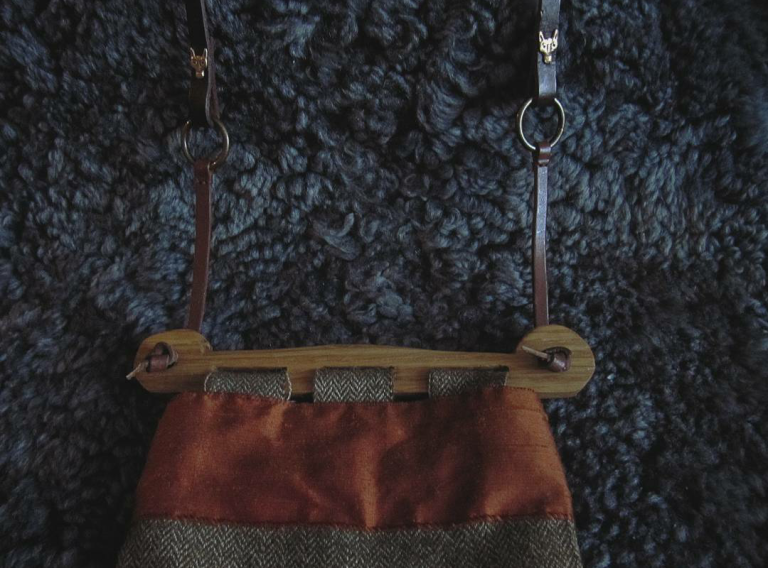



The pouch itself is sewn in a brown herringbone wool twill, lined with linen to avoid contents such as keys, etc. getting stuck in the wool fabric. The interior and exterior pouches are attached to each other, and to the handle straps, with the help of a two inch piece of silk. For shoulder strap I’ve used a belt strap divider and belt pieces from a modern belt. The animal head rivets are replicas of studs found on a tarsoly modelled belt bag in Birka grave 904, ordered from Historiska Fynd.



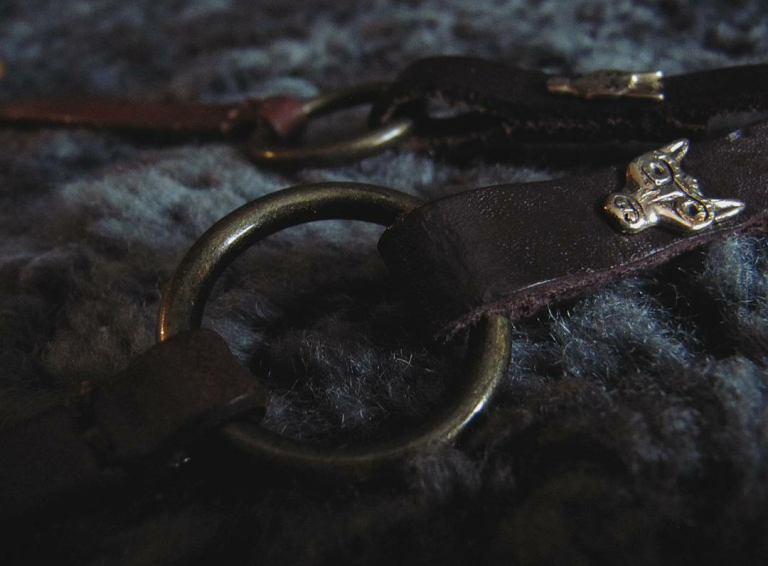



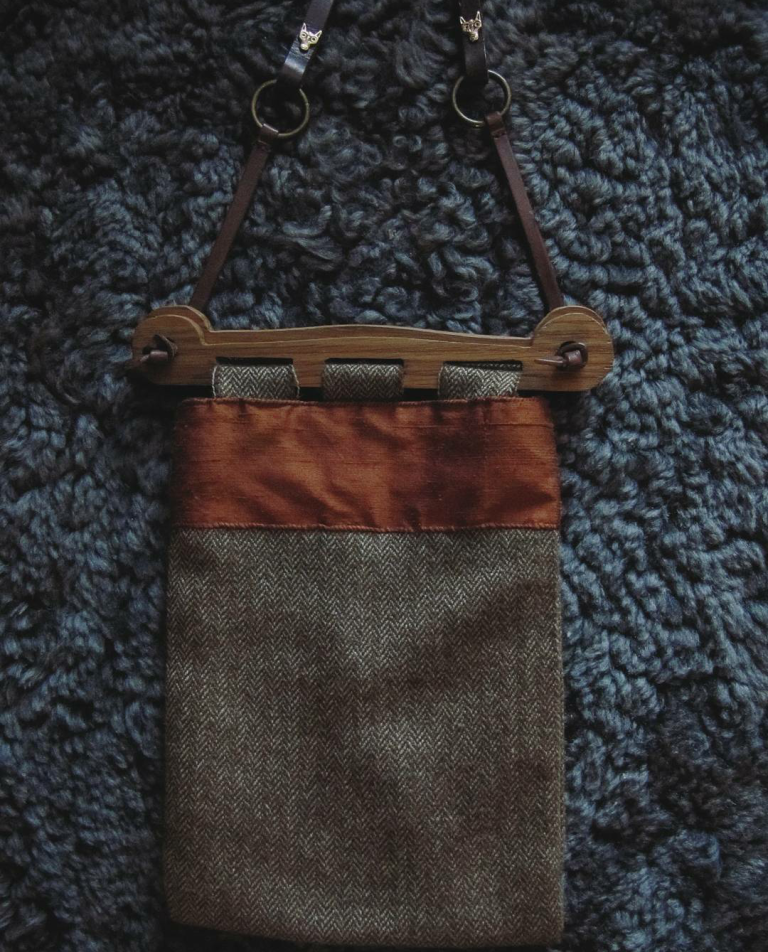
Feel free to use my simple downloadable Haithabu bag tutorial if you wish to make your own bag. Good luck!

Reference material
Arvid Julius – Ett lappländskt jordfynd i Uppsala, published in Uppsala Fornminnesförenings Tidskrift h. XXXIII, Uppsala 1918
Florian Westphal – Holzfunde von Haithabu (Die Ausgrabungen in Haithabu), K. Wachholtz, 2006
Ibn Butlán – Taqwim al-Sihhah (The maintenance of health/Tacuini sanitatis), Strasbourg 1531
Stockholm Maritime Museum’s exhibition of the Birka excavation in 2004 http://www.sjohistoriska.se/en/
Wikinger Museum Haithabu’s exhibition of the Haithabu excavation http://www.schloss-gottorf.de/haithabu/das-museum/viking-museum-haithabu











An excellent read, I’m looking for authentic finds from the area as my re-enactment character that I portray is a well travelled Norwegian mercenary. i’m going to dig deeper and if it comes up as favourable to me, it’ll be another interesting piece of my kit that I can inform others of.
LikeLike
Reblogged this on HymirBlog and commented:
Zajímavý článek o vikingské tašce.
LikeLike
Very helpful, thank you. Looking forward to making my own now.
LikeLike
Hi Roland,
Thank you for taking the time to read, I’m glad you found it helpful. Good luck in making your own bag!
LikeLike